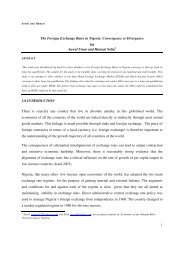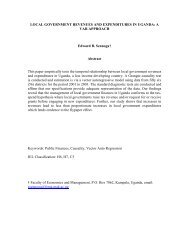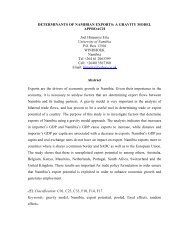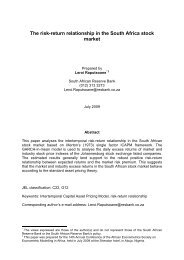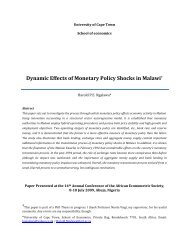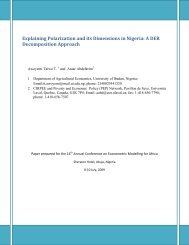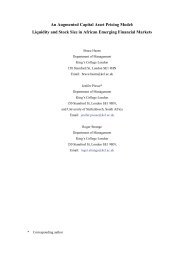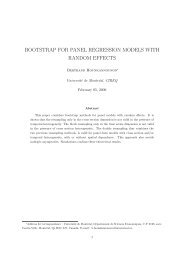Fiscal policy rules for managing oil revenues in Nigeria
Fiscal policy rules for managing oil revenues in Nigeria
Fiscal policy rules for managing oil revenues in Nigeria
Create successful ePaper yourself
Turn your PDF publications into a flip-book with our unique Google optimized e-Paper software.
expenditure, the ability to save w<strong>in</strong>dfalls from excess crude <strong>oil</strong> proceeds by the<br />
government rema<strong>in</strong>s critical <strong>in</strong> ensur<strong>in</strong>g that government expenditure is<br />
ma<strong>in</strong>ta<strong>in</strong>ed at a susta<strong>in</strong>able level and consistent with the absorptive capacity of<br />
the economy.<br />
Figure 1a reveals that there is a substantial <strong>in</strong>crease <strong>in</strong> government spend<strong>in</strong>g,<br />
primary deficit and debt <strong>in</strong> <strong>Nigeria</strong> between 1980 and 2005. The <strong>oil</strong> w<strong>in</strong>dfall<br />
between 1990 and 1992 was followed by rapid growth <strong>in</strong> government spend<strong>in</strong>g<br />
with an average of about 21 percent of GDP dur<strong>in</strong>g that period. However, as the<br />
<strong>oil</strong> market weakened <strong>in</strong> the subsequent years, <strong>oil</strong> receipts were not adequate to<br />
meet <strong>in</strong>creas<strong>in</strong>g levels of demands, and expenditures be<strong>in</strong>g re<strong>in</strong><strong>for</strong>ced by<br />
political pressures, were not rationalised. Government resorted to borrow<strong>in</strong>g<br />
ma<strong>in</strong>ly from the central bank to f<strong>in</strong>ance the huge deficits (see figure 1b).<br />
From figure 1b, the CBN absorbs almost half of the <strong>Nigeria</strong>n public debt<br />
follow<strong>in</strong>g Commercial bank and the public. This implies that government is<br />
ma<strong>in</strong>ly f<strong>in</strong>anc<strong>in</strong>g its huge deficits through seigniorage − the so called “fiscal<br />
<strong>in</strong>discipl<strong>in</strong>e.” And when government pr<strong>in</strong>ts money (or use seigniorage), it<br />
<strong>in</strong>creases the money supply and this <strong>in</strong> turn causes <strong>in</strong>flation.<br />
Although the democratically elected government <strong>in</strong> 1999 adopted policies to<br />
restore fiscal discipl<strong>in</strong>e, the rapid monetization of <strong>for</strong>eign exchange earn<strong>in</strong>gs<br />
between 2000 and 2004, another era of <strong>oil</strong> w<strong>in</strong>dfall, resulted <strong>in</strong> a large <strong>in</strong>creases<br />
<strong>in</strong> government spend<strong>in</strong>g. In 2005 alone, government spend<strong>in</strong>g <strong>in</strong>creases to 19<br />
percent of GDP from 14 percent <strong>in</strong> 2000. Extra budgetary outlays not <strong>in</strong>itially<br />
<strong>in</strong>cluded <strong>in</strong> the budget <strong>in</strong>creased. Worst till, most of this spend<strong>in</strong>g are not<br />
directed towards capital and socio-economic sectors.<br />
Corollary, primary deficit worsened from an average of 2.6 percent of GDP <strong>in</strong><br />
1980s to one of 6.2 percent <strong>in</strong> 1990s. In 2002 alone, primary deficit <strong>in</strong>creases<br />
to 5 percent of GDP from 2 percent <strong>in</strong> 2000. This <strong>in</strong>crease <strong>in</strong> deficits results <strong>in</strong><br />
4



